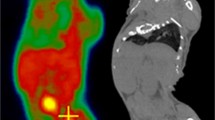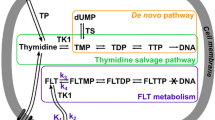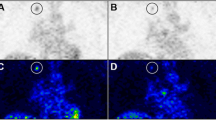Abstract
Purpose
3′-Deoxy-3′-[18F]fluorothymidine (FLT) is a promising new radiopharmaceutical for imaging cell proliferation. We evaluated whether FLT PET can be used to monitor early responses to radiation treatment.
Methods
C3H/HeN mice bearing murine squamous cell carcinomas were randomized to irradiation with 0, 10, or 20 Gy. Twenty-four hours later, the mice were sacrificed for histopathological and biological assessment such as cell cycle analysis, Hoechst staining, and clonogenic cell survival assay. PET scans were performed on other mice after injection of [18F]FLT or [18F]fluorodeoxyglucose (FDG) before and after radiation treatment, and tumor growth was assessed over 9 days.
Results
Histopathological examination detected no morphological changes 24 h after radiation treatment, but cell cycle analysis showed that irradiated tumors had a decreased fraction of cells in S phase and an increased fraction in G2–M phase, compared with nonirradiated tumors. Irradiated tumors also had a higher incidence of apoptotic features and reduced clonogenic cell survival. Tumor growth was significantly delayed in irradiated mice (p<0.001) compared with control mice. PET images showed increased tumoral uptake of both FLT and FDG before radiation treatment. Following irradiation, FLT uptake differed significantly (p=0.020) from that in control mice. In contrast, FDG uptake after irradiation did not differ significantly from that in control mice.
Conclusion
Our finding that tumor uptake of FLT was reduced at 24 h after radiation treatment suggests that FLT PET may be a promising imaging modality for monitoring the early effects of radiation therapy.






Similar content being viewed by others
References
Van de Wiele C, Lahorte C, Oyen W, Boerman O, Goethals I, Slegers G, et al. Nuclear medicine imaging to predict response to radiotherapy: a review. Int J Radiat Oncol Biol Phys 2003;55:5–15
Avril NE, Weber WA. Monitoring response to treatment in patients utilizing PET. Radiol Clin North Am 2005;43:189–204
Fornace A FZ, Weichselbaum RR, Milas L. Radiation therapy. In. Mendelsohn J, Howley PM, Israel MA, Liotta LA, editors. The molecular basis of cancer. Philadelphia: Saunders; 2001; p. 423–54
Therasse P, Arbuck SG, Eisenhauer EA, Wanders J, Kaplan RS, Rubinstein L, et al. New guidelines to evaluate the response to treatment in solid tumors. European Organization for Research and Treatment of Cancer, National Cancer Institute of the United States, National Cancer Institute of Canada. J Natl Cancer Inst 2000;92:205–16
Hicks RJ, MacManus MP, Matthews JP, Hogg A, Binns D, Rischin D, et al. Early FDG-PET imaging after radical radiotherapy for non-small-cell lung cancer: inflammatory changes in normal tissues correlate with tumor response and do not confound therapeutic response evaluation. Int J Radiat Oncol Biol Phys 2004;60:412–8
Erdi YE, Macapinlac H, Rosenzweig KE, Humm JL, Larson SM, Erdi AK, et al. Use of PET to monitor the response of lung cancer to radiation treatment. Eur J Nucl Med 2000;27:861–6
Nam SY, Lee SW, Im KC, Kim JS, Kim SY, Choi SH, et al. Early evaluation of the response to radiotherapy of patients with squamous cell carcinoma of the head and neck using18FDG-PET. Oral Oncol 2005;41:390–5
Castellucci P, Zinzani P, Nanni C, Farsad M, Moretti A, Alinari L, et al.18F-FDG PET early after radiotherapy in lymphoma patients. Cancer Biother Radiopharm 2004;19:606–12
Mankoff DA, Shields AF, Krohn KA. PET imaging of cellular proliferation. Radiol Clin North Am 2005;43:153–67
Lonneux M, Sibomana M, Pauwels S, Gregoire V. Current data and perspectives on positron emission tomography oncology-radiotherapy [in French]. Cancer Radiother 1999;3:275–88
Lowe V. PET and PET-CT in oncology. Berlin Heidelberg New York: Springer; 2003; p. 303–8
Hautzel H, Muller-Gartner HW. Early changes in fluorine-18-FDG uptake during radiotherapy. J Nucl Med 1997;38:1384–6
Sundoro-Wu BM, Schmall B, Conti PS, Dahl JR, Drumm P, Jacobsen JK. Selective alkylation of pyrimidyldianions: synthesis and purification of11C labeled thymidine for tumor visualization using positron emission tomography. Int J Appl Radiat Isot 1984;35:705–8
Christman D, Crawford EJ, Friedkin M, Wolf AP. Detection of DNA synthesis in intact organisms with positron-emitting (methyl-11C)thymidine. Proc Natl Acad Sci U S A 1972;69:988–92
Vander Borght T. Laber D, Pauwels S, Lambotte L. Production of [2–11C]thymidine for quantification of cellular proliferation with PET. Int J Rad Appl Instrum [A] 1991;42:103–4
Shields AF, Grierson JR, Dohmen BM, Machulla HJ, Stayanoff JC, Lawhorn-Crews JM, et al. Imaging proliferation in vivo with [F-18]FLT and positron emission tomography. Nat Med 1998;4:1334–6
Rasey JS, Grierson JR, Wiens LW, Kolb PD, Schwartz JL. Validation of FLT uptake as a measure of thymidine kinase-1 activity in A549 carcinoma cells. J Nucl Med 2002;43:1210–7
Toyohara J, Waki A, Takamatsu S, Yonekura Y, Magata Y, Fujibayashi Y. Basis of FLT as a cell proliferation marker: comparative uptake studies with [3H]thymidine and [3H]arabinothymidine, and cell-analysis in 22 asynchronously growing tumor cell lines. Nucl Med Biol 2002;29:281–7
He Q, Skog S, Welander I, Tribukait B. X-irradiation effects on thymidine kinase (TK): I. TK1 and 2 in normal and malignant cells. Cell Prolif 2002;35:69–81
Schwartz JL, Tamura Y, Jordan R, Grierson JR, Krohn KA. Effect of p53 activation on cell growth, thymidine kinase-1 activity, and 3′-deoxy-3′fluorothymidine uptake. Nucl Med Biol 2004;31:419–23
Sugiyama M, Sakahara H, Sato K, Harada N, Fukumoto D, Kakiuchi T, et al. Evaluation of 3′-deoxy-3′-18F-fluorothymidine for monitoring tumor response to radiotherapy and photodynamic therapy in mice. J Nucl Med 2004;45:1754–8
Dittmann H, Dohmen BM, Kehlbach R, Bartusek G, Pritzkow M, Sarbia M, et al. Early changes in [18F]FLT uptake after chemotherapy: an experimental study. Eur J Nucl Med Mol Imaging 2002;29:1462–9
Barthel H, Cleij MC, Collingridge DR, Hutchinson OC, Osman S, He Q, et al. 3′-deoxy-3′-[18F]fluorothymidine as a new marker for monitoring tumor response to antiproliferative therapy in vivo with positron emission tomography. Cancer Res 2003;63:3791–8
Leyton J, Latigo JR, Perumal M, Dhaliwal H, He Q, Aboagye EO. Early detection of tumor response to chemotherapy by 3′-deoxy-3′-[18F]fluorothymidine positron emission tomography: the effect of cisplatin on a fibrosarcoma tumor model in vivo. Cancer Res 2005;65:4202–10
Waldherr C, Mellinghoff IK, Tran C, Halpern BS, Rozengurt N, Safaei A, et al. Monitoring antiproliferative responses to kinase inhibitor therapy in mice with 3′-deoxy-3′-18F-fluorothymidine PET. J Nucl Med 2005;46:114–20
Oh SJ, Mosdzianowski C, Chi DY, Kim JY, Kang SH, Ryu JS, et al. Fully automated synthesis system of 3′-deoxy-3′-[18F]fluorothymidine. Nucl Med Biol 2004;31:803–9
Zhou BB, Elledge SJ. The DNA damage response: putting checkpoints in perspective. Nature 2000;408:433–9
Khanna KK, Jackson SP. DNA double-strand breaks: signaling, repair and the cancer connection. Nat Genet 2001;27:247–54
Little JB. Delayed initiation of DNA synthesis in irradiated human diploid cells. Nature 1968;218:1064–5
Munch-Petersen B, Cloos L, Jensen HK, Tyrsted G. Human thymidine kinase 1. Regulation in normal and malignant cells. Adv Enzyme Regul 1995;35:69–89
Coloma J, Castell JV. Isozyme pattern of thymidine kinase during liver regeneration. Hoppe Seylers Z Physiol Chem 1984;365:457–62
Ellims PH, Van der Weyden MB, Medley G. Thymidine kinase isoenzymes in human malignant lymphoma. Cancer Res 1981;41:691–5
Sakamoto S, Iwama T, Tsukada K, Utsunomiya J, Kawasaki T, Okamoto R. Increased activity of thymidine kinase isozyme in human colon tumor. Carcinogenesis 1984;5:183–5
Elledge SJ. Cell cycle checkpoints: preventing an identity crisis. Science 1996;274:1664–72
Lane DP. Cancer. p53, guardian of the genome. Nature 1992;358:15–6
Fei P, El-Deiry WS. P53 and radiation responses. Oncogene 2003;22:5774–83
Boothman DA, Davis TW, Sahijdak WM. Enhanced expression of thymidine kinase in human cells following ionizing radiation. Int J Radiat Oncol Biol Phys 1994;30:391–8
Kreder NC, van Bree C, Peters GJ, Loves WJ, Haveman J. Enhanced levels of deoxycytidine kinase and thymidine kinase 1 and 2 after pulsed low dose rate irradiation as an adaptive response to radiation. Oncol Rep 2002;9:141–4
Saito Y, Milross CG, Hittelman WN, Li D, Jibu T, Peters LJ, et al. Effect of radiation and paclitaxel on p53 expression in murine tumors sensitive or resistant to apoptosis induction. Int J Radiat Oncol Biol Phys 1997;38:623–31
Kubota K, Ishiwata K, Kubota R, Yamada S, Tada M, Sato T, et al. Tracer feasibility for monitoring tumor radiotherapy: a quadruple tracer study with fluorine-18-fluorodeoxyglucose or fluorine-18-fluorodeoxyuridine,L-[methyl-14C]methionine, [6-3H]thymidine, and gallium-67. J Nucl Med 1991;32:2118–23
Furuta M, Hasegawa M, Hayakawa K, Yamakawa M, Ishikawa H, Nonaka T, et al. Rapid rise in FDG uptake in an irradiated human tumour xenograft. Eur J Nucl Med 1997;24:435–8
Weber G. Enzymology of cancer cells (second of two parts). N Engl J Med 1977;296:541–51
Flier JS, Mueckler MM, Usher P, Lodish HF. Elevated levels of glucose transport and transporter messenger RNA are induced by ras or src oncogenes. Science 1987;235:1492–5
Acknowledgements
Supported by a grant of the National Cancer Control R&D Program 2003, Ministry of Health & Welfare, Republic of Korea (No. 0320280–2).
Author information
Authors and Affiliations
Corresponding author
Rights and permissions
About this article
Cite this article
Yang, YJ., Ryu, JS., Kim, SY. et al. Use of 3′-deoxy-3′-[18F]fluorothymidine PET to monitor early responses to radiation therapy in murine SCCVII tumors. Eur J Nucl Med Mol Imaging 33, 412–419 (2006). https://doi.org/10.1007/s00259-005-0011-4
Received:
Accepted:
Published:
Issue Date:
DOI: https://doi.org/10.1007/s00259-005-0011-4




